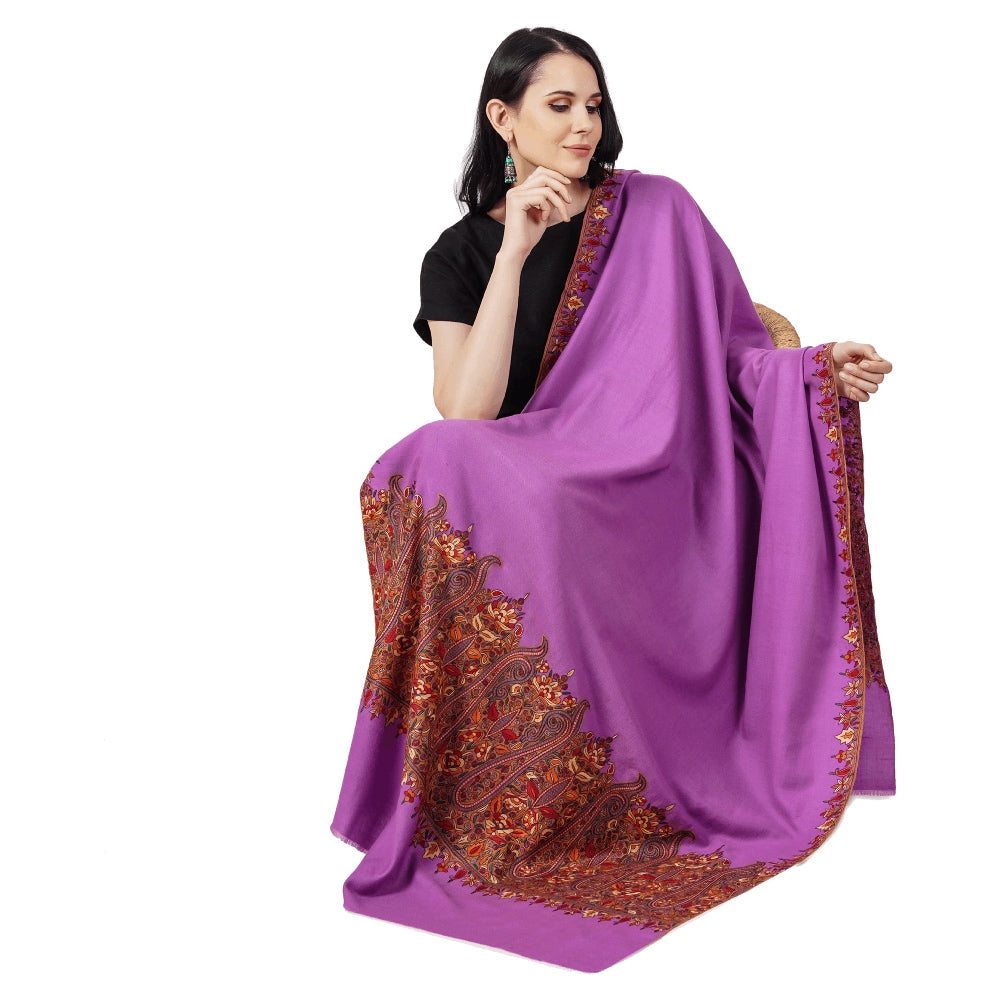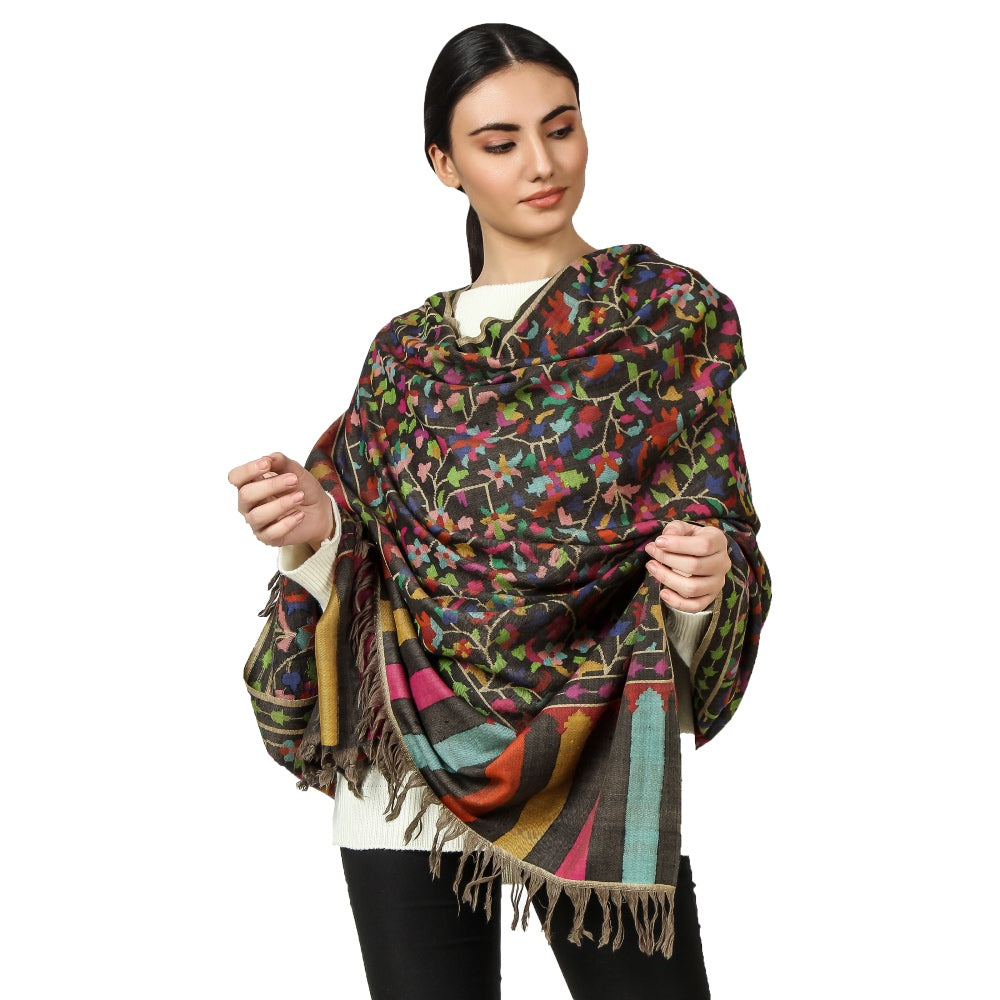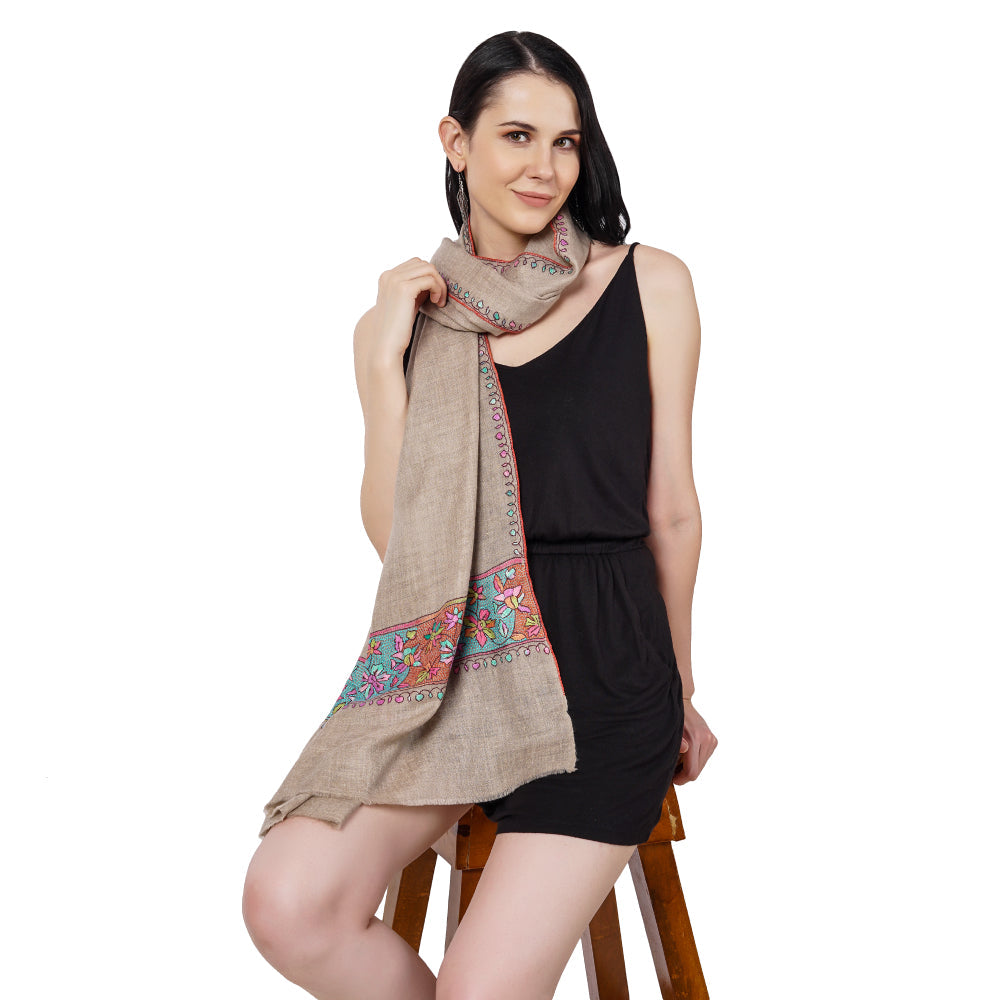
Which region is famous for Pashmina Shawl?
Share
Pashmina shawls have long been regarded as a symbol of luxury, elegance, and sophistication. These exquisite shawls are made from the wool of the Pashmina goat, which is found in the high-altitude regions of Asia, primarily in India, Nepal, and Mongolia. In recent years, the popularity of Pashmina shawls has surged, and they have become a must-have accessory in the wardrobe of fashion-conscious individuals worldwide.

The history of Pashmina shawls can be traced back to ancient times, where they were worn by royalty and the wealthy elite as a mark of their social status. The exquisite texture, softness, and warmth of Pashmina wool made it highly coveted among the wealthy, who would pay a premium price for these shawls. Pashmina shawls were also given as precious gifts to foreign dignitaries and rulers, which helped to spread their popularity beyond the borders of India and other Pashmina-producing countries.
Today, Pashmina shawls have become a global fashion icon, adored for their timeless elegance and versatility. From everyday wear to special occasions, Pashmina shawls are a perfect addition to any outfit. Furthermore, the significance of Pashmina shawls extends beyond their fashion appeal, as they are also a vital part of the cultural heritage of the regions where they are produced. In this article, we will explore the origins and popularity of Pashmina shawls and unravel the mystery behind their allure.
Also read: What is the point of Pashmina?
What is Pashmina?
Pashmina is a type of wool that comes from the Pashmina goat, which is primarily found in the high-altitude regions of Asia. The name "Pashmina" comes from the Persian word "pashm," which means soft or delicate. Pashmina wool is known for its fineness, softness, and warmth, making it highly coveted among wool connoisseurs.

Pashmina wool is harvested from the undercoat of the Pashmina goat, which is combed out during the spring season when the goats naturally shed their winter coats. The wool fibers are incredibly fine, with a diameter of just 14-19 microns, making them much thinner than human hair. This fineness gives Pashmina wool its characteristic softness and lightweight feel, making it ideal for shawls and other clothing items.
One of the unique characteristics of Pashmina wool is its warmth, despite its lightweight texture. Pashmina wool fibers have a natural crimp that traps air pockets, creating a layer of insulation that keeps the wearer warm in cold weather. Additionally, Pashmina wool is also highly breathable, which means it can regulate body temperature and prevent overheating in warmer weather.
When compared to other types of wool, Pashmina stands out for its exceptional softness and fineness. Other types of wool, such as Merino or Cashmere, may be softer than regular wool but are still coarser than Pashmina. Additionally, Pashmina wool has a unique sheen and luster that sets it apart from other types of wool. These qualities make Pashmina wool highly desirable and sought after by those who appreciate the finest quality of wool.
Also read: The ultimate guide to Pashmina
History of Pashmina Shawls

The history of Pashmina shawls can be traced back to ancient times, where they were worn by royalty and the wealthy elite as a mark of their social status. The earliest records of Pashmina shawls date back to the 3rd century BC, where they were mentioned in Sanskrit texts as a luxury item. In the 14th century, the Kashmiri ruler Zain-ul-Abidin introduced Pashmina shawls to the royal courts of India, where they gained widespread popularity among the nobility.
Over time, the production of Pashmina shawls became an integral part of the traditional clothing of different cultures, including India, Nepal, and Mongolia. In these regions, Pashmina shawls were not only used as a fashion accessory but also as a functional piece of clothing to protect against the harsh mountain climates.
The popularity of Pashmina shawls continued to grow, and by the 19th century, they had become a prized possession among European royalty and the upper class. Pashmina shawls were highly sought after for their intricate designs, softness, and warmth, and were often given as gifts to visiting dignitaries.
In the modern era, Pashmina shawls have become a staple in the global fashion industry, with designers incorporating them into their collections and creating new designs that appeal to contemporary tastes. The timeless elegance and versatility of Pashmina shawls have made them a popular accessory among people of all ages and backgrounds.
Also read: A Journey through time : The history of Pashmina Shawls
The Making of Pashmina Shawls
The making of Pashmina shawls is a complex and time-consuming process that involves several steps. The first step in making a Pashmina shawl is to collect the Pashmina wool from the undercoat of the Pashmina goat. The wool is harvested by combing the goat's coat by hand, which is a delicate and painstaking process. The collected wool is then washed and cleaned to remove any impurities.

Once the Pashmina wool has been cleaned, it is ready for spinning and weaving. In the traditional method, the wool is hand-spun using a spinning wheel, which creates a fine and even thread. The thread is then woven on a handloom using a traditional technique called Kani, which involves the use of small wooden sticks to create intricate patterns and designs.
In modern times, the process of making Pashmina shawls has been streamlined with the use of modern machinery. Automated spinning machines can create a more consistent and even thread, while power looms can weave larger quantities of fabric at a faster rate. However, many artisans still prefer to use traditional methods, as they believe that it produces a higher quality and more authentic product.
Regardless of the method used, the making of a Pashmina shawl requires skill and precision. The weavers must be highly skilled in creating complex designs and patterns, which can take weeks or even months to complete. Once the shawl has been woven, it is finished with a delicate embroidery or fringe, which adds to its beauty and elegance.

The making of a Pashmina shawl is a laborious and intricate process that requires a high level of skill and attention to detail. Whether made using traditional methods or modern techniques, the resulting shawl is a work of art that embodies the rich cultural heritage and fine craftsmanship of the Pashmina industry.
Also read: The Making of Pashmina Shawls
V. Pashmina Shawls and Sustainability
Sustainability has become an increasingly important concern in the fashion industry, and the Pashmina industry is no exception. In recent years, efforts have been made to promote sustainable practices in Pashmina production, including the use of eco-friendly dyes, the reduction of water usage, and the adoption of fair labor practices.

The production of Pashmina has an impact on the environment and local communities. Pashmina goats are primarily found in high-altitude regions of the Himalayas, which are ecologically fragile areas. Overgrazing by Pashmina goats can lead to soil erosion and the destruction of vegetation, which can have a negative impact on the local ecosystem. However, efforts are being made to promote sustainable grazing practices and to protect the delicate mountain environments where the goats live.
The Pashmina industry also has ethical considerations to take into account. The demand for Pashmina shawls has led to the exploitation of local communities and workers, who are often paid low wages and work in poor conditions. In recent years, efforts have been made to promote fair labor practices and to ensure that workers are paid a living wage and work in safe and healthy environments.
In conclusion, the Pashmina industry has a responsibility to promote sustainable practices and to consider the impact of its production on the environment and local communities. While there are challenges to overcome, such as the need to balance economic development with ecological conservation and the protection of worker's rights, the industry has made strides towards promoting sustainability and ethical practices. By adopting a holistic approach to production, the Pashmina industry can ensure that it continues to thrive while also promoting social and environmental responsibility.
Also read: Do goats die for Cashmere and Pashmina?
Pashmina Shawls and Fashion
Pashmina shawls have been a fashion staple for centuries and continue to be a popular accessory today. They come in a variety of styles and designs, ranging from traditional to contemporary. Traditional Pashmina shawls are typically woven with intricate patterns and designs using a traditional technique called Kani. Modern Pashmina shawls, on the other hand, feature a range of designs, including stripes, polka dots, and floral prints.

Colors play an important role in the design of Pashmina shawls. Classic colors such as ivory, black, and grey are always popular, but bright, bold colors and patterns have become increasingly trendy in recent years. Popular colors include rich jewel tones, such as emerald green and sapphire blue, as well as soft pastels and vibrant neons.
Pashmina shawls are versatile accessories that can be styled and worn in many different ways. They can be draped over the shoulders as a traditional shawl, or wrapped around the neck as a scarf. They can also be used as a head wrap or turban, or even as a belt or sash. Styling options are endless, and Pashmina shawls can be paired with a wide range of outfits, from casual jeans and t-shirts to formal evening wear.
In conclusion, Pashmina shawls are a timeless fashion accessory that continues to evolve with changing fashion trends. With their intricate designs, bold colors, and versatile styling options, Pashmina shawls offer a unique blend of fashion and functionality. Whether worn as a traditional shawl, a scarf, or even a belt, a Pashmina shawl is sure to add a touch of elegance and sophistication to any outfit.
How to Identify Authentic Pashmina Shawls
With the popularity of Pashmina shawls, there are many fake and low-quality imitations on the market. It can be difficult to identify authentic Pashmina shawls, but there are a few key characteristics to look for.

Firstly, authentic Pashmina shawls are made from the fine wool of the Changthangi goat, which is native to the high-altitude regions of the Himalayas. The wool is known for its softness, warmth, and lightweight texture. Authentic Pashmina shawls should have a soft, silky feel, and should not be scratchy or rough to the touch.
Another characteristic of authentic Pashmina shawls is the thickness of the fabric. Pashmina wool is incredibly fine, so authentic shawls should be thin and lightweight. However, they should also have a dense weave that provides warmth and insulation.
One common misconception about Pashmina shawls is that they are always expensive. While authentic Pashmina shawls can be quite expensive due to the time-consuming process of collecting and weaving the wool, there are also many affordable options available. However, if a Pashmina shawl is being sold at an incredibly low price, it is likely a fake or low-quality imitation.
To identify a fake Pashmina shawl, look for signs of synthetic materials, such as acrylic or polyester, in the fabric. Fake Pashmina shawls may also have inconsistent patterns or designs, and may not have the soft, silky texture of authentic Pashmina wool. Additionally, check the label or packaging for any information about the origin of the wool and the production process. Authentic Pashmina shawls will usually include information about the region where the wool was sourced and the traditional techniques used to weave the shawl.
In summary, authentic Pashmina shawls are made from high-quality, fine wool and should have a soft, silky texture and a dense weave. They can be expensive, but there are also affordable options available. To identify fake Pashmina shawls, look for signs of synthetic materials and inconsistent patterns or designs. Always check the label or packaging for information about the origin of the wool and the production process.
Famous Regions for Pashmina Shawls
Kashmir, located in northern India, is perhaps the most famous region for Pashmina shawls. The state of Jammu and Kashmir is known for its rich cultural heritage and skilled artisans, who have been producing Pashmina shawls for centuries. The unique climate and topography of the region provide ideal conditions for raising the Changthangi goat, which produces the fine Pashmina wool.

The process of making Pashmina shawls in Kashmir is a traditional craft that has been passed down through generations. The wool is collected during the spring shedding season, when the goats naturally shed their wool. The wool is then sorted, washed, and spun by hand, using traditional spinning wheels. The spun yarn is then woven on handlooms, often in intricate patterns and designs.
Kashmiri Pashmina shawls are known for their softness, warmth, and durability. They come in a variety of colors and designs, ranging from traditional patterns to modern styles. Kashmiri Pashmina shawls are often adorned with intricate embroidery, known as "sozni," which adds to their beauty and elegance.
Pashmina shawls from Kashmir have gained international recognition for their quality and craftsmanship. They are exported to countries around the world and are a popular choice for those seeking a luxurious and high-quality shawl. While there are other regions that produce Pashmina shawls, Kashmir remains the most famous and sought-after region for these exquisite pieces.
Buying Pashmina Shawls
Pashmina shawls can be purchased from a variety of sources, including specialty boutiques, online retailers, and local markets in regions where they are produced. When purchasing Pashmina shawls, it is important to ensure that they are authentic and of high quality.
The price of Pashmina shawls can vary widely, depending on the quality of the wool, the complexity of the design, and the craftsmanship involved in producing the shawl. Authentic Pashmina shawls are typically priced in the range of several hundred to several thousand dollars.
When purchasing a Pashmina shawl, it is important to consider factors such as the quality of the wool, the craftsmanship of the piece, and the reputation of the seller. It is also important to be aware of common scams and to verify the authenticity of the shawl before making a purchase.
Caring for Pashmina Shawls
Proper care and maintenance are essential for prolonging the life of a Pashmina shawl. Pashmina shawls should be dry cleaned or hand washed with gentle soap and cold water. It is important to avoid using hot water or harsh detergents, which can damage the delicate fibers of the shawl.
Pashmina shawls should be stored in a cool, dry place, away from direct sunlight and moisture. They should be folded carefully and stored flat to avoid stretching or damaging the fibers.
To prolong the life of a Pashmina shawl, it is important to avoid wearing it in situations where it may be subjected to excessive wear or damage, such as in heavy rain or wind.
Frequently Asked Questions about Pashmina Shawls
What makes Pashmina shawls so expensive?
Pashmina shawls are expensive due to the rarity and high quality of the wool used to make them, as well as the intricate and time-consuming craftsmanship involved in producing each piece.
How can I tell if a Pashmina shawl is genuine?
Genuine Pashmina shawls are made from the fine undercoat of the Changthangi goat, and are lightweight, soft, and warm to the touch. They also have a distinctive sheen and drape. Authentic Pashmina shawls are typically priced in the range of several hundred to several thousand dollars.
Can Pashmina shawls be worn in warm weather?
Yes, Pashmina shawls can be worn in warm weather, as they are lightweight and breathable. They can also be worn as a fashion accessory to add a touch of elegance to an outfit.
What are some ways to style a Pashmina shawl?
Pashmina shawls can be worn in a variety of ways, including draped over the shoulders, wrapped around the neck, or used as a headscarf. They can also be paired with a range of outfits, from casual to formal attire.
XII. Conclusion
In conclusion, Pashmina shawls are a luxurious and high-quality fashion accessory that has a rich history and cultural significance. The production of Pashmina shawls involves intricate craftsmanship and attention to detail, and the wool used to make them is rare and highly prized. Proper care and maintenance are essential for prolonging the life of a Pashmina shawl, and buyers should be aware of common scams and verify the authenticity of the shawl before making a purchase. Despite their expense, Pashmina shawls continue to be a popular choice for those seeking a touch of elegance and luxury in their wardrobe.




